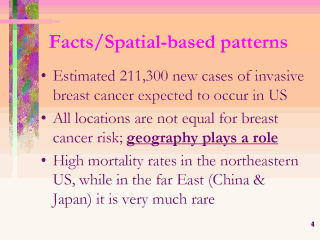| front |1 |2 |3 |4 |5 |6 |7 |8 |9 |10 |11 |12 |13 |14 |15 |16 |17 |18 |19 |20 |21 |22 |23 |24 |25 |26 |27 |28 |29 |review |
 |
Previous studies shown that the northeastern United States has about a 16% higher breast cancer mortality rate than the rest of the country 1. All locations are not equal for breast cancer risk; geography plays a role. What is clear is that there are geographic patterns in breast cancer cases, and the analysis of these patterns can help us develop hypotheses about risks and focus investment in research and intervention on the most significant areas 2. An estimated 211,300 new cases of invasive breast cancer are expected to occur among women in the United States during 2003 3. Furthermore, an estimated 40,200 deaths (39,800 women, 400 men) are anticipated from breast cancer in 2003. Breast cancer incidence rates have continued to increase since 1980, although the rate of increase slowed in the 1990s, compared to the 1980s 3. In the more recent time period, breast cancer incidence rates have increased only in those aged 50 and over. The mortality rates declined by 1.4% per year during 1989-1995 and by 3.2% afterwards, with the largest decreases in younger women in both whites and African Americans. These decreases are probably the result of both earlier detection and improved treatment. The ultimate cause of the disease is unknown 4, but several risk factors have been identified. Previous studies have shown breast cancer mortality and incidence rates vary by geographic region in the United States 1,5. Breast cancer is most common in North America and Western Europe, account for about one in four female cancers in these regions, while in the Far East (China and Japan) 6; it is very much rare. Breast cancer rates among Asian-Americans are lower than those of U.S. whites but considerably higher than rates prevailing in Asia 6. It is suspected that migration to the US brings about a change in endocrine function among Asian women, although reasons for this change remain obscure 5,7. The geographic patterns of cancer around the world and within countries have provided important clues to the causes of cancer 8. The highest incidence rates of all are found in Hawaii, where a rate of 93.9 per 100,000 female population has been reported, and in US white women. The incidence rises with age from about age 30 5. There are ethnic variations, such as a high incidence in Israeli Jews compared with non-Jews in Israel. It is more common in single women, in higher social classes, and in urban rather than rural areas 5. About 1% of cases occurs in males. Mortality has increased less rapidly than incidence, but breast cancer is most common cause of cancer death 7. |